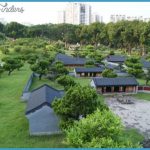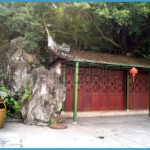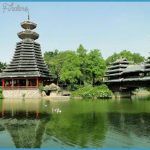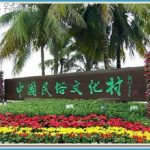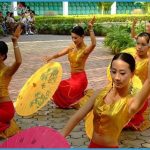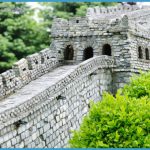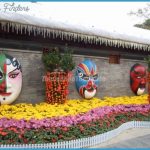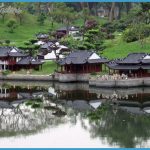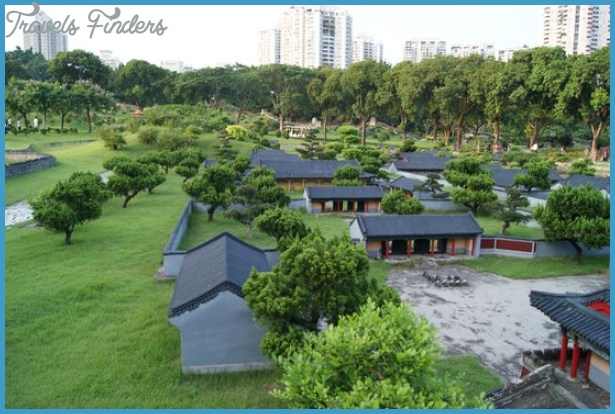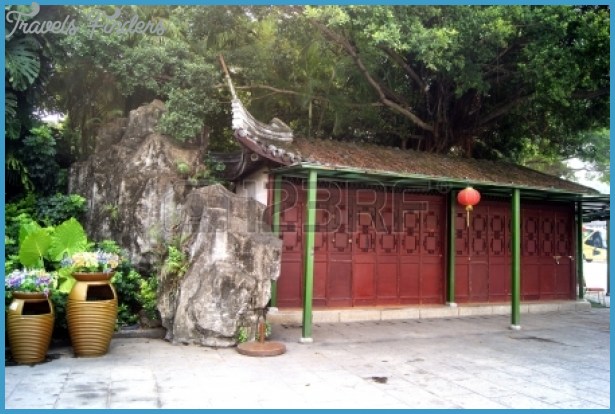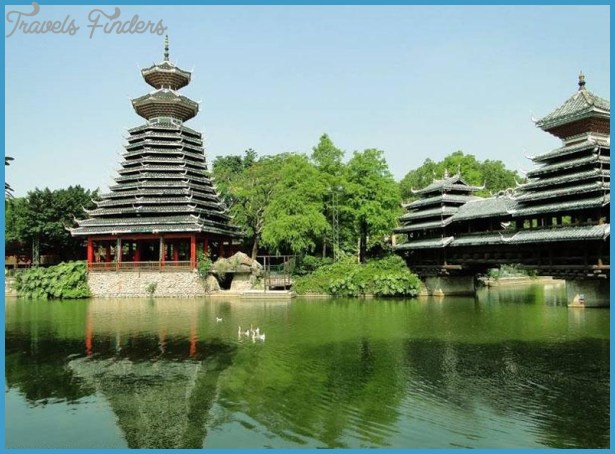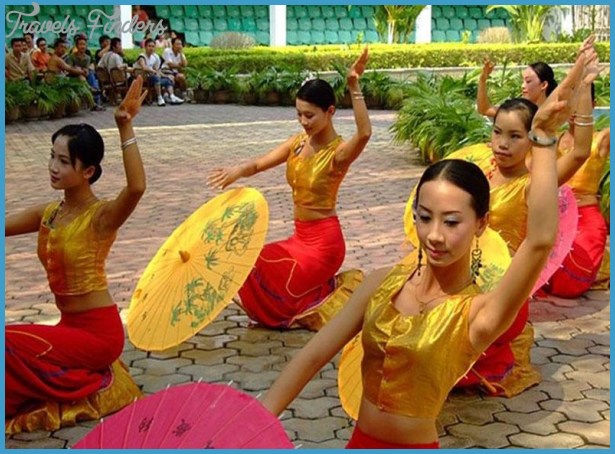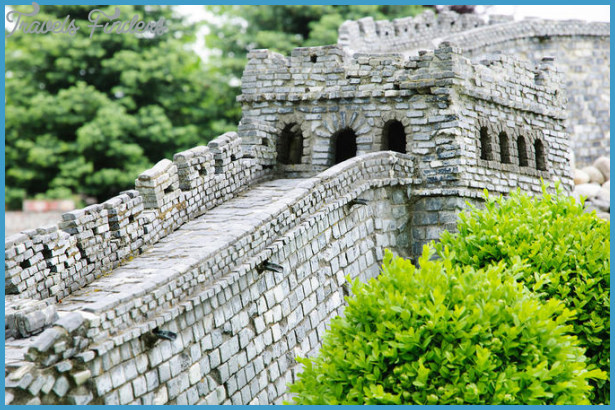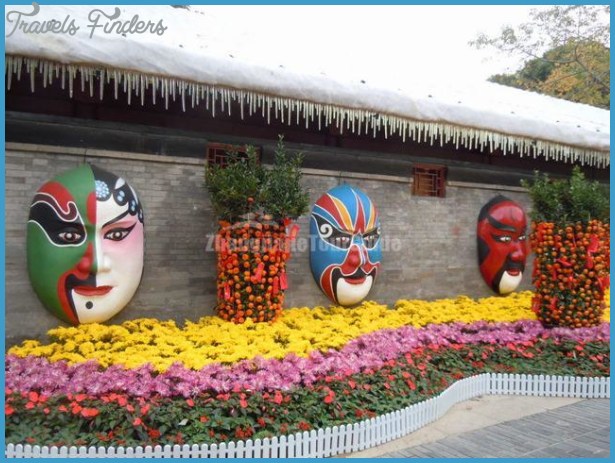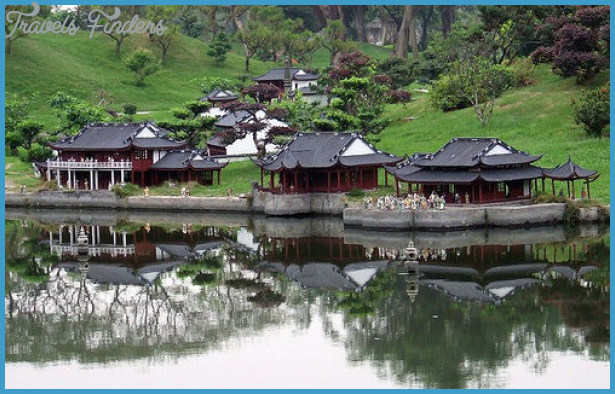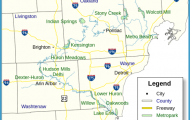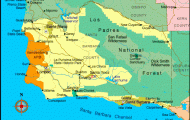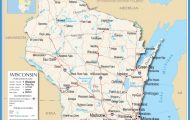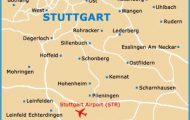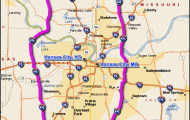This is adjacent to Splendid China and provides an experience of China’s diversity, with representative folk art, performances and model villages from all of China’s colourful minority cultures.
Ultimately you have Stalin to thank for the China Folk Customs Village. Stalin was the author of a paper on the minorities question in the Soviet Union that was read and followed carefully by his disciples in the Chinese Communist Party. Part of the repudiation of the 19th century shaming of China was the restoration of China’s borders at the height of its 18th century expansion under the Qian Long Emperor and this meant recovering and holding on to areas such as Tibet, Xinjiang and Inner Mongolia which weren’t basically Chinese. Thus was born China’s minorities’ policy, one of the manifestations of which is a lot of emphasis on quaintness in dress, customs and culture.
But you don’t have to know about any of this to enjoy the folk village. Our first visit was on October 1, China’s National Day. Not a good day for doing much at all, I hear the more sensible people say. Stay at home and watch bad movies on TV. But we were smarter than that. We’d been at the airport on September 30 and observed at least 15 million people leaving town for more inviting climes and had equally observed not many people coming in the opposite direction. So it was with some confidence that we set out towards Overseas Chinese Town.
Wrong.
It rapidly became apparent that at least several hundred thousand people hadn’t joined the National Day exodus and that most of them were competing with us for space at the Folk Customs Village. Groups of girls giggling and taking photos of each other, boys in US college T-shirts, the occasional granny being supported by her kids whether she needed it or not, couples in his and hers clothes, but most of all kids. Kids in their thousands, laughing, crying, yelling. It was like waking up and finding yourself locked up in the fifties again. Shenzhen was living up to its reputation as China’s demographically youngest city.
We wove our way through the crowds and slipped through the gates. Soon we were in a maze of the strange rocks so loved by Chinese garden designers. This was a reproduction of the Kunming Forest of Stones, and even though the stones were artificial, the total result with banyan trees and cool groves of bamboo was surprisingly effective. This was in the spirit of Shenzhen’s many great gardens. The garden impression was further reinforced when we rounded a corner and heard an enormous roar. A hundred foot high artificial waterfall dumped enormous amounts of water into a wide rushing stream. In the days before the Special Economic Zone, this had been part of the Shahe Overseas Chinese State Farm and this area had been extensive fishponds that had now been converted into a system of Garden ponds and streams. Artificial hills had been built on what had previously been flat land and densely planted with tropical vegetation.
The streams and gardens are also the basis of some of the fun associated with the Village. We sat on the Miao Nationality covered bridge, a fine construction with multiple roofs, and watched as middle management executives rode a flying fox, zipping down from the top of the waterfall along the river. Behind us between heavily wooded banks, people were tentatively steering round rubber vessels, which appeared to have some form of motor. We observed the lack of any form of traffic control and hoped that the engines weren’t too powerful.
The exhibits are fun if somewhat lacking in complete authenticity but, as with all the OCT theme parks, what you’re really there for is the shows. These go on all day and late into the night. Round one corner and suddenly the unmistakable strains of Turkish music. Yes, we were in the Uighur dance display. Then round another corner and there was a Ming Dynasty music show on a fairly authentic Ming style open-air opera stage. Not bad either. The truly bizarre is never all that far away in Shenzhen and in this case it took the shape of a Tibetan rock ‘n’ roll band. But against all expectations they were good too.
We found the piece de resistance of the Folk Customs Village in a specially constructed stadium. Actually it announced itself about 100 yards before we saw the stadium when the rich smell of horse manure started to waft past our nose. Yes, we had found the famous Mongol battleground.
The performance takes the form of a horseback battle between Mongol horsemen and Chinese troops outside the gates of a city. The Mongols are real Mongols who take the whole thing very seriously. Talking with them outside the stadium we couldn’t raise a single smile from them. This was serious business. We assumed that the city was Chinese but this was a little unclear. The city gates were inscribed in both Mongol and Chinese. But it was clear that the Mongols were not going to get through the gates. Mongols and Chinese may well be brothers and co-nationalities of the state but the idea that the
Mongols might win was a little Thirteenth Century. And to further blur the lines of Chinese nationality, the Chinese troops heroically defending the city were carefully lined up under the authentic colour banners of the seventeenth century Manchu army. But it was a lot of fun with noise and hard riding and plenty of action.
Apart from that, there is lots of souvenir shopping of variable quality and some excellent food. We sampled Dai food, which is just Thai food by a different name, and fed our addiction to Uighur food with its mutton kebabs with sesame seeds.
China Folk Customs Village is amongst the theme parks at Overseas Chinese Town. Address Shennan Ave
OCT
Open 9 am 9.30 pm Entry is $120
Metro: Hua Qiao Cheng line 1, Exit D Buses 101,113,201,204,209,223,301

